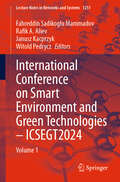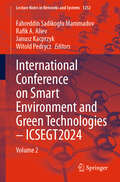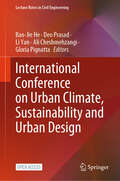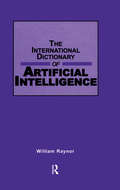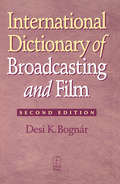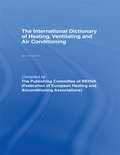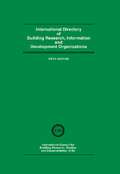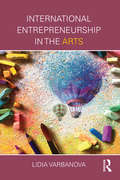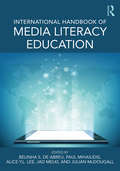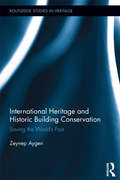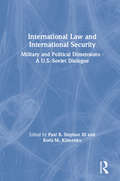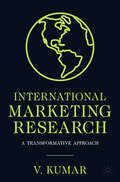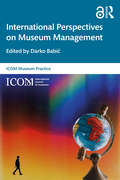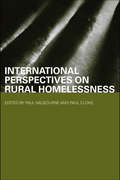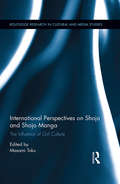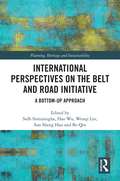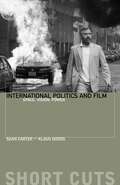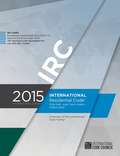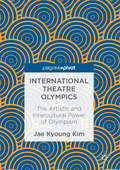- Table View
- List View
International Conference on Neural Computing for Advanced Applications: 4th International Conference, NCAA 2023, Hefei, China, July 7–9, 2023, Proceedings, Part II (Communications in Computer and Information Science #1870)
by Haijun Zhang Zhao Zhang Tianyong Hao Weizhi Meng Zhou Wu Yinggen Ke Yuanyuan MuThe two-volume set CCIS 1869 and 1870 constitutes the refereed proceedings of the 4th International Conference on Neural Computing for Advanced Applications, NCAA 2023, held in Hefei, China, in July 2023.The 83 full papers and 1 short paper presented in these proceedings were carefully reviewed and selected from 211 submissions. The papers have been organized in the following topical sections: Neural network (NN) theory, NN-based control systems, neuro-system integration and engineering applications; Machine learning and deep learning for data mining and data-driven applications; Computational intelligence, nature-inspired optimizers, and their engineering applications; Deep learning-driven pattern recognition, computer vision and its industrial applications; Natural language processing, knowledge graphs, recommender systems, and their applications; Neural computing-based fault diagnosis and forecasting, prognostic management, and cyber-physical system security; Sequence learning for spreading dynamics, forecasting, and intelligent techniques against epidemic spreading (2); Applications of Data Mining, Machine Learning and Neural Computing in Language Studies; Computational intelligent Fault Diagnosis and Fault-Tolerant Control, and Their Engineering Applications; and Other Neural computing-related topics.
International Conference on Smart Environment and Green Technologies – ICSEGT2024: Volume 1 (Lecture Notes in Networks and Systems #1251)
by Witold Pedrycz Janusz Kacprzyk Rafik A. Aliev Fahreddin Sadikoglu MammadovThis book compiles state-of-the-art studies and real-world applications in ecosystems and smart environments. It covers important subjects like creating a sustainable economy, green and renewable energy, and IoT-powered industrial and agricultural systems. Along with providing insights into theory, modelling, and the deployment of smart cities and infrastructure, the book also examines the use of AI in the earth and environmental sciences and economy. The book is intended to be a priceless tool for scholars, professionals, and recent graduates. It acts as a manual and source of inspiration for promoting environmentally friendly technologies and sustainable solutions. It opens the door for creating intelligent systems that maximise resource use, reduce carbon footprints, and enhance general quality of life by incorporating the most recent technological developments.
International Conference on Smart Environment and Green Technologies – ICSEGT2024: Volume 2 (Lecture Notes in Networks and Systems #1252)
by Witold Pedrycz Janusz Kacprzyk Rafik A. Aliev Fahreddin Sadikoglu MammadovThis book compiles state-of-the-art studies and real-world applications in ecosystems and smart environments. It covers important subjects like creating a sustainable economy, green and renewable energy, and IoT-powered industrial and agricultural systems. Along with providing insights into theory, modelling, and the deployment of smart cities and infrastructure, the book also examines the use of AI in the earth and environmental sciences and economy. The book is intended to be a priceless tool for scholars, professionals, and recent graduates. It acts as a manual and source of inspiration for promoting environmentally friendly technologies and sustainable solutions. It opens the door for creating intelligent systems that maximise resource use, reduce carbon footprints, and enhance general quality of life by incorporating the most recent technological developments.
International Conference on Urban Climate, Sustainability and Urban Design (Lecture Notes in Civil Engineering #559)
by Li Yan Ali Cheshmehzangi Deo Prasad Bao-Jie He Gloria PignattaThis open access book is a proceeding of the International Conference on Urban Climate, Sustainability, and Urban Design in Mianyang (MYUCSUD). This work focuses on the latest thoughts, ideas, models, methods, solutions, and practices on urban climate mitigation and adaptation through sustainable planning and design, covering interdisciplinary topics in architecture, urban-rural planning, meteorology, building and construction engineering, material engineering, geographic sciences, public health, public administration, computer sciences, etc. This book can provide students and researchers from urban planning, urban design, urban meteorology, civil and construction engineering and urban governance with better understanding of urban climate sciences, innovative ideas, and tangible solutions.
International Construction Management Research (Spon Research)
by Igor MartekThis book lays out the evolution of the often contested construction management discipline. How is the field defined? What has been discovered to date? Who are the researchers involved? Where is the research being conducted? What national priorities exist among the many nations now grappling with how to absorb foreign construction expertise, or compete in the global commons? Despite the overwhelming economic and political importance of the global construction industry and its impact on the world, until now, there has been no book dedicated to describing the body of research in the field, or where the knowledge frontier lies.This book is the first of its kind, offering a comprehensive appraisal of the state of play in the emerging field of international construction management (ICM) research. It will serve as a reference guide for academics and researchers embarking on or already active in global construction management research. It lays out who the researchers are, along with their fields of expertise, the institutions dedicated to ICM research, global research trends, the journals accepting ICM research, and a country-by-country analysis of national research priorities. It will assist the fledgling PhD and the budding researcher, as well as the discipline expert, in making better decisions on how to advance the field of international construction management through research that both augments CM education and directly benefits the industry.
International Dictionary of Artificial Intelligence
by William RaynorFirst Published in 1998. Artificial intelligence is increasingly employed in all areas of human endeavor and industry. Anticipating the needs of professionals, researchers, and students alike, International Dictionary of Artificial Intelligence defines and illustrates over 2,500 terms and provides detailed explanations of major concepts as well as topics in related disciplines. The Dictionary also contains an annotated bibliography and an extensive appendix of World Wide Web sites devoted to the latest trends and developments in the world of artificial intelligence.
International Dictionary of Broadcasting and Film
by Desi BognarNo matter what continent you are on, the distinct professional language of radio and television broadcasters and film and video makers remains the same. Still the only reference that is international in scope, The International Dictionary of Broadcasting and Film, Second Edition is a comprehensive guide to professional filmmaking and broadcasting terminology. Entries also include information on professional organizations, festivals and awards. Appendices contain tables of international television and film standards, frequencies and channels, and a list of national and international news agencies and their standard abbreviations. This book has been substantially revised and updated to include coverage of the new digital technology, plus information on the history of film and broadcasting. It is a valuable reference to professionals in broadcasting and filmmaking, as well to students in these fields. Desi K. Bognar is a three-time Fulbright scholar in media who has been a documentary filmmaker, writer, reporter, producer, and broadcasting/film consultant. He lives in Peacham, Vermont.
International Dictionary of Heating, Ventilating and Air Conditioning
by REHVAThe Dictionary is divided into two sections. The main sequence of the book consists of some 4,000 terms given in English, in alphabetical order, with their translations. The remainder of the book consists of alphabetical indexes for the other eleven languages covered: French, German, Italian, Danish, Finnish, Dutch, Spanish, Swedish, Hungarian, Polish and Russian. Each alphabetical index is keyed to serial numbers which refer the user to the correct item in the main sequence.
International Directory of Building Research Information and Development Organizations
by International Council for Building Research, Studies and DocumentationEvery entry follows a standard pattern: after the address and telephone number of the institution there is a brief description of its history and financial support, followed by the names of the senior staff, total number of staff, the institution's structure and services, its main research programmes and a list of its publications. For this new edition a subject index has been added, allowing the reader to identify centres of research activity on individual construction topics throughout the world. The world-wide investment in construction industry research is enormous. This unique directory is a guidebook to that investment which will enable its readers to isolate sources of advice on practical problems, information on national standards and requirements and potential research collaborators.
International Encyclopedia of Adolescence
by Jeffrey Jensen ArnettIn pre-industrial societies, people moved from childhood to adulthood directly, getting married and going to work early in life. Although this still holds true for many cultures, in countries such as the USA or Japan, adolescence has become a specific stage of life, where young people are cultural trendsetters and market drivers. The International Encyclopedia of Adolescence is an exhaustive socio-cultural survey of young people around the world. The focus is cultural and historical, and the work offers a rarely found worldwide perspective. Entries are compiled by experts from many fields of study, including anthropology, history, psychology, and sociology. Unlike existing works, the Encyclopedia does not stress biological or psycho-pathological issues. It addresses myths and realities of adolescence by looking at the actual life of young people in regions as varied as Iran, India, France, the USA, or Japan. It also explains how teen cultures have developed in some countries and how young people deal with the conflicts between tradition and modernity in others. Country coverage examines cultural beliefs, gender, personal and cultural identity, relationships (familial), friends and peers, love and sexuality, education, work, media, problems, and outlook for the future, plus topics particular to the culture or region discussed.
International Entrepreneurship in the Arts
by Lidia VarbanovaInternational Entrepreneurship in the Arts focuses on teaching students, artists, and arts managers specific strategies for expanding creative ventures that are already successful domestically to an international audience. Varbanova’s accessible writing outlines a systematic theoretical framework that guides the reader from generating an innovative idea and starting up an international arts enterprise to its sustainable international growth. Applying concepts, models, and tools from international entrepreneurship theory and practice, Varbanova analyzes how these function within the unique setting of the arts and culture sector. The book covers: Domestic inception of an arts enterprise, followed by international expansion Starting up an international arts venture in the early stages of its inception Presenting an arts activity or project in a foreign country or region Financing a startup venture with international resources Implementing diverse models of international partnership Starting up an arts venture that is run by a multinational team Creating an art product with international dimension The book’s 23 case studies and 54 short examples feature disciplines from fine arts and photography to music, theatre, and contemporary dance, and cover ventures in over 20 countries to provide students with practical insight into the issues and challenges facing real arts organizations. Aimed at students interested in the business aspects of arts and cultural ventures, it will also be of use to practitioners looking at ways to internationalize their own enterprises.
International Handbook of Media Literacy Education
by Paul Mihailidis Belinha S. De Abreu Julian McDougall Alice Y.L. Lee Jad MelkiAt the forefront in its field, this Handbook examines the theoretical, conceptual, pedagogical and methodological development of media literacy education and research around the world. Building on traditional media literacy frameworks in critical analysis, evaluation, and assessment, it incorporates new literacies emerging around connective technologies, mobile platforms, and social networks. A global perspective rather than a Western-centric point of view is explicitly highlighted, with contributors from all continents, to show the empirical research being done at the intersection of media, education, and engagement in daily life. Structured around five themes—Educational Interventions; Safeguarding/Data and Online Privacy; Engagement in Civic Life; Media, Creativity and Production; Digital Media Literacy—the volume as a whole emphasizes the competencies needed to engage in meaningful participation in digital culture.
International Heritage and Historic Building Conservation: Saving the World’s Past
by Zeynep AygenThe majority of books in English on historic building conservation and heritage preservation training are often restricted to Western architecture and its origins. Consequently, the history of building conservation, the study of contemporary paradigms and case studies in most universities and within wider interest circles, predominantly in the UK, Europe, and USA focus mainly on Europe and sometimes the USA, although the latter is often excluded from European publications. With an increasingly multicultural student body in Euro-American universities and with a rising global interest in heritage preservation, there is an urgent need for publications to cover a larger geographical and social area including not only Asia, Australia, Africa and South America but also previously neglected countries in Europe like the new members of the European Community and the northern neighbour of the USA, Canada. The inclusion of the ‘other’ in built environment education in general and in building conservation in particular is a pre-requisite of cultural interaction and widening participation. International Heritage and Historic Building Conservation assesses successful contemporary conservation paradigms from around the world. The book evaluates conservation case studies from previously excluded areas of the world to create an integrated account of Historic Building Conservation that crosses the boundaries of language and culture and sets an example for further inclusive research. Analyzing the influence of financial constraints, regional conflicts, and cultural differences on the heritage of disadvantaged countries, this leading-edge volume is essential for researchers and students of heritage studies interested in understanding their topics in a wider framework.
International Law and International Security: Military and Political Dimensions - A U.S.-Soviet Dialogue
by Paul B. Stephan, III Boris M. KlimenkoThis volume brings together experts and political actors from the United States and the USSR to assess the status of international law in the post-Cold War era with the intention of contributing ideas, judgements, and proposals tempered by experience. The topics covered range from terrorism to peaceful conflict resolution; from the renunciation of aggression to the right of self-defence; from chemical, biological, and nuclear weapons limitations to problems of verification; and from the military use of space to the right of political self-determination. Each chapter features contributions by both US and Soviet experts who have themselves participated in high-level policy making and international negotiations in the area (including, for example, the ABM, SALTI, SALTII, CFE, and START talks).
International Marketing Research: A Transformative Approach
by V. KumarThis book provides a practical, detailed, and well-documented guide that takes students and market researchers through all phases of developing and conducting global marketing research. This book not only accounts for the recent developments in the scope and extent of global marketing research, but also examines advances in both quantitative and qualitative research techniques, and the impact of the Internet on research in the global environment.It includes coverage of all phases involved in designing and executing global marketing research -- from analyzing the nature and scope of the research to the preliminary stages, gathering data, designing the questionnaires, sampling, and presenting the data. Numerous country-specific examples and case studies will add to the understanding of the concepts laid out in the book. This edition features updates related to leveraging the power of AI, Internet of Things, machine learning, blockchain, robotics, the metaverse, and otheremerging technologies that are impacting the way in which marketing research is performed. With an instructor’s manual as well as PPT slides covering major topics within the chapters, in addition to numerous cases, this text provides the most current and relevant information about the global marketing research industry and outlines the necessary techniques that can guide researchers in their work.
International Perspectives on Disability Exceptions in Copyright Law and the Visual Arts: Feeling Art
by Jani McCutcheon and Ana RamalhoThis book provides an overview of disability exceptions to copyright infringement and the international and human rights legal framework for disability rights and exceptions. The focus is on those exceptions as they apply to visual art, while the book presents a comprehensive study of copyright’s disability exceptions per se and the international and human rights law framework in which they are situated. 3D printing now allows people with a visual impairment to experience 3D reproductions of paintings, drawings and photographs through touch. At the same time, the uncertain application of existing disability exceptions to these reproductions may generate concerns about legal risk, hampering sensory art projects and reducing inclusivity and equity in cultural engagement by people with a visual impairment. The work adopts an interdisciplinary approach, with contributions from diverse stakeholders, including persons with disabilities, cultural institutions and the 3D printing industry. The book sketches the scene relating to sensory art projects. Experts in intellectual property, human rights, disability and art law then critically analyse the current legal landscape relating to disability access to works of visual art at both international and regional levels, as well as across a broad representative sample of national jurisdictions, and identify where legal reform is required. This comparative analysis of the laws aims to better inform stakeholders of the applicable legal landscape, the legal risks and opportunities associated with sensory art and the opportunities for reform and best practice guidelines, with the overarching goal of facilitating international harmonisation of the law and enhanced inclusivity.
International Perspectives on Museum Management (ICOM Museum Practice)
by Darko BabićInternational Perspectives on Museum Management is the first volume of the ICOM Museum Practice series. Exploring contemporary practices in the field of museum management, the book demonstrates how strategic vision and effective leadership can enable museums to fulfil their varied roles and empower staff to achieve their individual and collective objectives.Gathering together contributions that shed light on key aspects of running a museum in different parts of the world, the volume examines a wide range of topical issues from a management perspective. Chapters within the volume focus on governance and operations, communication and marketing, accessibility and community engagement, the decline in public funding, sustainability and risk management and planning a new museum or a renewal. As a whole, the book demonstrates that competent and creative museum management is vital to museums’ ability to survive and thrive in the face of decreased investment in culture and shifting expectations on the roles that museums should play within society.Containing insights from respected museum professionals around the world and focusing on topical issues, International Perspectives on Museum Management will be essential reading for museum practitioners working in all types and sizes of museum. The book will also be of great interest to students and academics who have an interest in museum management.The Open Access version of this book, available at www.taylorfrancis.com , has been made available under a Creative Commons Attribution-Non Commercial-No Derivatives (CC-BY-NC-ND) 4.0 license.
International Perspectives on Rural Homelessness (Housing, Planning and Design Series)
by Paul Cloke Paul MilbourneDrawing on recent academic studies in North America, Europe, Australia and New Zealand, this book is the first international text on homelessness in rural areas. Consisting of fifteen specially commissioned chapters, International Perspectives on Rural Homelessness provides comparative material on the cultural, political and policy contexts of rural homelessness, examining the nature and scale of the issue and the complex local geographies of rural homelessness.
International Perspectives on Shojo and Shojo Manga: The Influence of Girl Culture (Routledge Research in Cultural and Media Studies)
by Masami TokuThis collaborative book explores the artistic and aesthetic development of shojo, or girl, manga and discusses the significance of both shojo manga and the concept of shojo, or girl culture. It features contributions from manga critics, educators, and researchers from both manga’s home country of Japan and abroad, looking at shojo and shojo manga’s influence both locally and globally. Finally, it presents original interviews of shojo manga-ka, or artists, who discuss their work and their views on this distinct type of popular visual culture.
International Perspectives on the Belt and Road Initiative: A Bottom-Up Approach (Planning, Heritage and Sustainability)
by Shannon Morreira Hao Wu Sun Sheng Han Bo Qin Wenqi LinInternational Perspectives on the Belt and Road Initiative investigates the most significant global‐scale international trade expansion and capital investment programme since the Second World War. This book focuses on the multi-national perspectives of the Belt and Road Initiative (BRI) in order to interrogate the Chinese government’s representation of it as a symbol of ‘peace, cooperation, development and mutual benefit.' With specific focus on the interrelationship between geopolitics, infrastructure investments and urban regional development, the book reflects on 12 countries’ experiences in depth, including those of Iran, Pakistan, Brazil, Thailand, Indonesia, Japan and Ethiopia, specificly to their economic development levels, political systems, power dynamics and socio-environmental issues. The book clarifies and contributes new knowledge on the nature of BRI concerning its relationship to globalism, neo-colonialism, the notion of developed vs developing countries and their institutions and macro-micro benefits and impacts. In doing so, the book offers a balanced account of the antagonistic geo-political narrative of socio-political conflict and the collaborative framework of real socio-economic flows and development. The book will appeal to academics, researchers and policy-makers with an interest in the BRI and its impacts on politico-economic development and urban, regional and spatial systems in the Indo-Pacific and beyond.
International Politics and Film
by Sean CarterInternational Politics and Film introduces readers to the representational qualities of film but also draws attention to how the relationship between the visual and the spatial is constitutive of international politics. Using four themes -- borders, the state of exception, homeland and distant others -- the territorial and imaginative dimensions of international affairs in particular are highlighted. But theis volume also makes clear that international politics is not just something 'out there'; film helps us better understand how it is also part of everyday life within the state -- affecting individuals and communities in different ways depending on axes of difference such as gender, race, class, age, and ethnicity.
International Politics and Film: Space, Vision, Power (Short Cuts)
by Klaus Dodds Sean CarterInternational Politics and Film introduces readers to the representational qualities of film but also draws attention to how the relationship between the visual and the spatial is constitutive of international politics. Using four themes—borders, the state of exception, homeland and distant others—the territorial and imaginative dimensions of international affairs in particular are highlighted. But this volume also makes clear that international politics is not just something "out there"; film helps us better understand how it is also part of everyday life within the state—affecting individuals and communities in different ways depending on axes of difference such as gender, race, class, age, and ethnicity.
International Residential Code For One- and Two-Family Dwellings
by International Code Council StaffThis comprehensive code for homebuilding combines building, plumbing, mechanical, fuel gas, energy, and electrical provisions into a single resource. The 2015 INTERNATIONAL RESIDENTIAL CODE FOR ONE- AND TWO- FAMILY DWELLINGS LOOSE LEAF uses these provisions to provide detailed insight into the construction of one- and two-family dwellings and townhouses up to three stories high. Using foundational principles that facilitate the use of new materials and building designs to guide the content, this reference guide also establishes minimum regulations using prescriptive provisions. This updated code includes information on common walls separating townhouses, remodeling of an existing basement, ramps that do not serve the required egress door, and carbon monoxide alarms.
International Symposium on Intelligent Informatics: Proceedings of ISI 2022 (Smart Innovation, Systems and Technologies #333)
by Kuan-Ching Li Sabu M. Thampi Jayanta Mukhopadhyay Marcin PaprzyckiThis book constitutes thoroughly refereed post-conference proceedings of the 7th International Symposium on Intelligent Informatics (ISI 2022), from August 31 to September 1–2, 2022, Trivandrum, India. The revised papers presented are carefully reviewed and selected from several initial submissions. The scope of the Symposium includes AI, machine learning, cognitive computing, soft computing, security informatics, data science, computer vision, pattern recognition, intelligent software engineering, intelligent networked systems, IoT, cyber-physical systems, and NLP. The book is directed to the researchers and scientists engaged in various fields of intelligent informatics.
International Theatre Olympics
by Jae Kyoung KimThis pivot examines how the Theatre Olympics, born in 1995, have served to enrich each host country's culture, community, and foreign relations. Looking at the host country's political, social, and cultural circumstances, it considers how the festival expands the notion of Olympism beyond its application to the Olympic Games, expressing the spirit of Olympism and interculturalism in each country's distinct cultural language. It also emphasizes the festival's development over the twenty years of its existence and how each festival's staging has reflected the national identity, theatre tradition, and cultural interest of the hosting country at that time, as well as how each festival director's artistic principle has attempted to accomplish cultural exchange through their productions.

